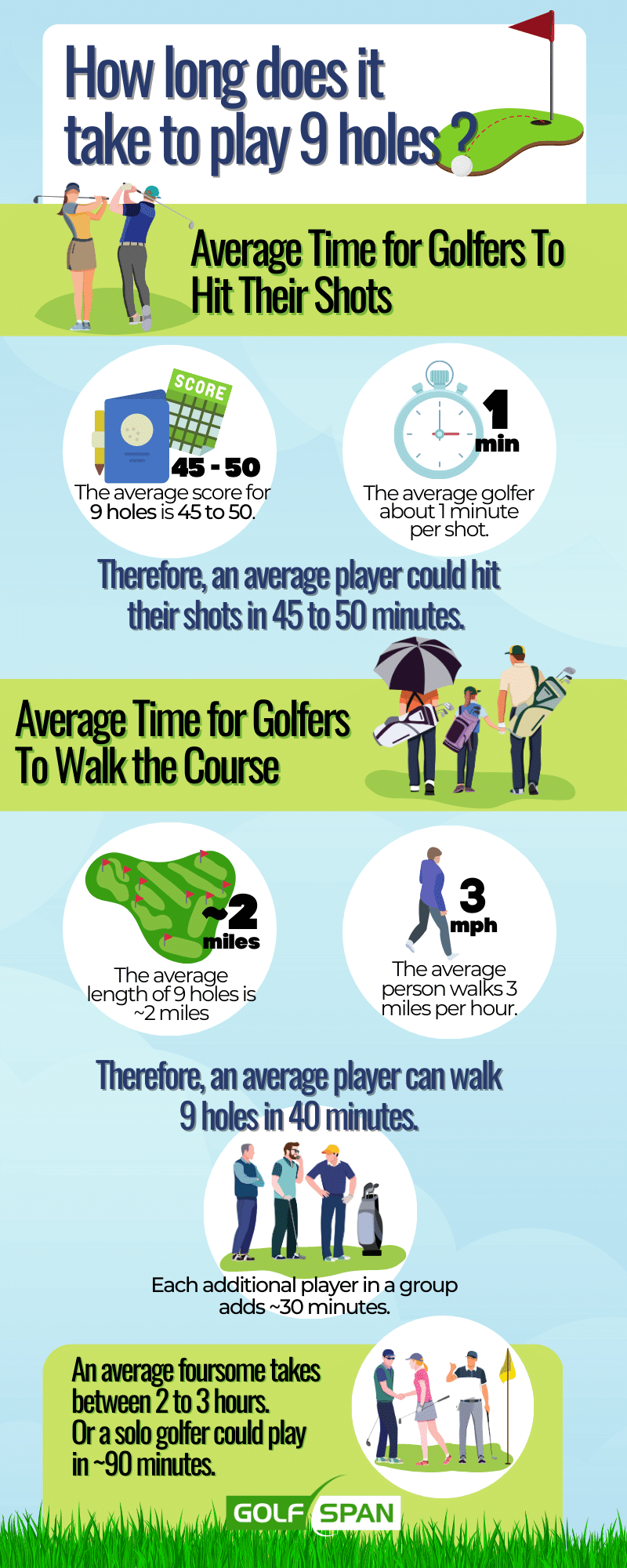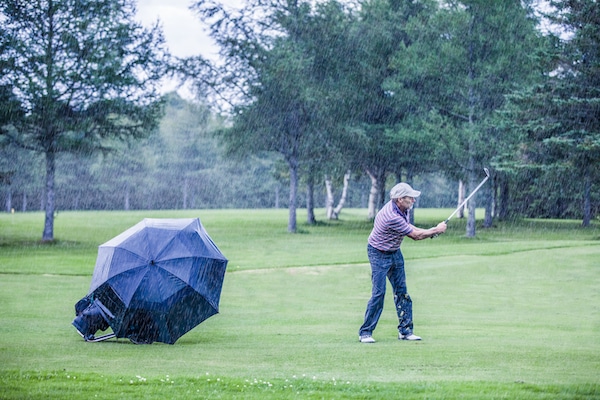For two players to play 9 holes, 2 hours is a good estimate, but it could be closer to 3 hours if you are both beginners. If you’re instead playing with a group of 3, 2 hours 30 minutes is around average. Most foursomes will take 3 hours.
Beyond the number of players you golf with, many factors influence how long 9 holes will take. This includes your experience, whether walking or riding to each hole, weather conditions, and more. Consider reading this entire post to estimate your round as accurately as possible.
As a golf professional with nearly three decades of experience, I’ve learned how to estimate my round and even speed up my game when necessary.

How Long Does It Take to Play 9 Holes?
On average, it takes two golfers around 2 hours to complete 9 holes. This is because an average course is around 2 miles long and a regular walking pace is 3 mph. This means simply walking the course takes 40 minutes.
As for hitting the ball, you are looking at around 45-50 minutes. This is because 45-50 is the average score and each hole usually takes 1 minute. This gives us 1 hour and 30 minutes in total for one player.
Each successive player adds 30 minutes to this time window. For tee shots, it’s 9 per round, taking 1 minute each, and for putts, it’s 18-24 per round (2-3 per hole) which is also 1 minute each.
- 1 player: 1 hour 30 minutes
- 2 players: 2 hours
- 3 players: 2 hours 30 minutes
- 4 players: 3 hours
Skip below this section if you just want the answer and are curious about the factors. Or you can see how to estimate how long it would take you to play 9 holes based on average figures.
Read More: How Long Does 18 Holes of Golf Take? (Official Average Times!)
Factors That Influence Pace of Play In Golf

Many factors influence pace of play in golf. These factors include, but may not be limited to the following:
- Number of Players
- Experience of Players
- Time of Day or Week
- Walking vs Riding in Carts
- Pre-shot Routine
- Tee Time Intervals
- Course Layout and Conditions
- Format of Play
Number of Players
It is common for a tee time slot on the tee sheet to be taken up by four golfers. That number is more or less the standard, especially on busy days at a golf course. If you’re playing with 4 people, less than 3 hours should be the goal.
Experience of Players
Newer golfers tend to take longer to make their shots. They also might hit a shot into the deep rough, so you’ll have to factor in extra walking time.
Time of Day or Week
The time you choose to play golf greatly influences how long your round takes. This is because you can tick all other boxes regarding speed but be bottlenecked by a slower group in front.
As such, you should carefully consider when you hit the course — especially if you’re pressed for time. The best time to go is weekdays in the afternoon as many golfers struggle to fit this into their schedule — you may even find yourself playing on an empty golf course.
On the flip side, morning sessions on the weekend are the busiest as almost everyone is off work, and they like to hit the course early.
Walking vs. Riding in a Cart
How long does it take to play 9 holes of golf with a cart? It might surprise you that on average, it takes nearly the same amount of time to play golf with a cart as walking, which is 2 hours for 2 players.
How can that be? Golf carts are generally sent out with two players per cart. But golfers often hit their golf balls in different directions. With two in a cart, you’ll spend more time going to each ball separately.
Pre-shot Routine
While a pre-shot routine is essential to golf, many players take far too long executing theirs. This is because they wait until it is time to swing before they begin their pre-shot routine — this is needless and somewhat inconsiderate to your fellow players.
Tee Time Intervals
The spacing between each group in the course can vary greatly based on a course’s philosophy.
But anywhere from 7 to 10 minutes between groups is common.
Courses that use this philosophy could be seen as “giving up” starting times. This could be seen as lost revenue. However, they are setting themselves up for less slow play issues and happier golfers.
Course Layout and Conditions
If the course you’re playing on has a lot of “bottle-neck” holes, it can slow down your round.
Identifying potential “bottle-neck” holes is paramount in creating a good pace of play. “Bottle-neck” holes are likely par-3 holes, drivable par-4 holes, and two-shot par-5s. This is especially true if they fall within a course’s first two or three holes.
Their Pace of Play Best Practices report estimates how long it will take you to play each hole.
| Par 3 | Par 4 | Par 5 | |
| Group of Two | 11 mins | 13 mins | 15 mins |
| Group of Three | 13 mins | 15 mins | 17 mins |
Format of Play
Finally, the play format can contribute to how long it takes to play 9 or 18 holes.
Take a four-person charity scramble, for example. These events usually have on-course games to help raise money. These take time. It is also common for unseasoned golfers to play in scrambles. This, too, can contribute to rounds lasting up to three hours for 9 holes and as many as 6 hours for 18 holes.
Tips on How To Improve Your Pace for 9 Holes

Before diving into the factors that can affect your pace of play, here are a few quick tips to shorten the time it takes you to play a round.
- Dress to stay dry and warm in the fall and cool in the summer.
- Consider walking instead of using a cart
- Turn off your phone
- Improve your pre-shot routine
- Consider going to courses with longer tee time intervals
- Consider courses with helpful marshals
- Avoid courses with many par-3s, drivable par-4s, and two-shot par-5s
Read More: The 8 Most Expensive Golf Courses in the World by Green Fees
FAQ
Brendon is Class A PGA Professional and founded Little Linksters, LLC, and its nonprofit arm, the Little Linksters Association for Junior Golf Development. He won 25+ prestigious industry honors, including the 2017 PGA National Youth Player Development Award. He graduated from the PGA of America Management Program and has a handicap index of 7.8.
He has played golf for over 40 years and currently plays twice a month at the Eagle Dunes Golf Club near Sorrento, Florida. He loves Srixon clubs and plays a ZX5 driver with Z 585 irons. He's written over 60 articles on GolfSpan and specializes in sharing tips to improve your golf game. You can connect with Brendon at LinkedIn, X, IG, FB, his website, or BrendonElliott@pga.com.







